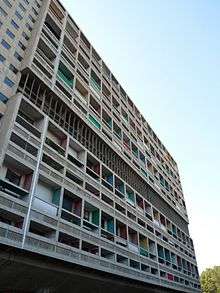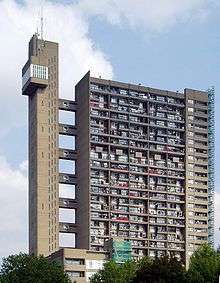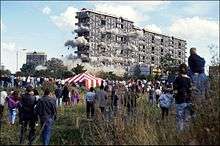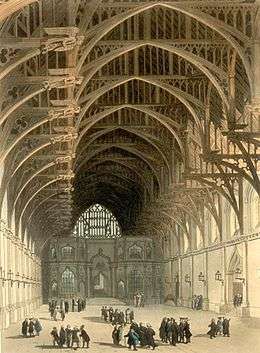Brutalist architecture
Brutalist architecture is a movement in architecture that flourished from the 1950s to the mid-1970s, descending from the modernist architectural movement of the early 20th century. The term originates from the French word for "raw" in the term used by Le Corbusier to describe his choice of material béton brut (raw concrete).[1][2] British architectural critic Reyner Banham adapted the term into "brutalism" (originally "New Brutalism") to identify the emerging style.
Brutalism became popular with governmental and institutional clients, with numerous examples in Britain, France, Germany, Japan, the United States, Italy, Canada, Brazil, the Philippines, Israel and Australia. Examples are typically massive in character (even when not large), fortress-like, with a predominance of exposed concrete construction, or in the case of the "brick brutalists," ruggedly combine detailed brickwork and concrete. There is often an emphasis on graphically expressing in the external elevations and in the whole-site architectural plan the main functions and people-flows of the buildings. Brutalism became popular for educational buildings (especially university buildings), but was relatively rare for corporate projects. Brutalism became favoured for many government projects, high-rise housing, and shopping centres.
In its ruggedness and lack of concern to look comfortable or easy, Brutalism can be seen as a reaction by a younger generation to the lightness, optimism, and frivolity of some 1930s and 1940s architecture. In one critical appraisal by Banham, Brutalism was posited not as a style but as the expression of an atmosphere among architects of moral seriousness. "Brutalism" as an architectural critical term was not always consistently used by critics; architects themselves usually avoided using it altogether. More recently, "brutalism" has become used in popular discourse to refer to buildings of the late twentieth century that are large or unpopular – as a synonym for "brutal."
History

The term "brutalism" was originally coined by the Swedish architect Hans Asplund to describe Villa Göth in Uppsala, designed in 1949 by his contemporaries Bengt Edman and Lennart Holm. He originally used the Swedish-language term nybrutalism (new brutalism), which was picked up by a group of visiting English architects, including Michael Ventris. In England, the term was further adopted by architects Alison and Peter Smithson.[3][4] The term gained wide currency when the British architectural historian Reyner Banham used it in the title of his 1966 book, The New Brutalism: Ethic or Aesthetic?, to characterise a somewhat recently established cluster of architectural approaches, particularly in Europe.[4]
The best known proto Brutalist architecture is the work of the Swiss architect Le Corbusier, in particular his 1952 Unité d'Habitation and the 1953 Secretariat Building (Palace of Assembly) in Chandigarh, India. Brutalism gained considerable momentum in the United Kingdom during the mid-twentieth century, as economically depressed (and World War II-ravaged) communities sought inexpensive construction and design methods for low-cost housing, shopping centres, and government buildings. Nonetheless, many architects chose the Brutalist style even when they had large budgets, as they appreciated the 'honesty', the sculptural qualities, and perhaps, the uncompromising, anti-bourgeois, nature of the style.
Combined with the socially progressive intentions behind Brutalist streets in the sky housings such as Corbusier's Unité, Brutalism was promoted as a positive option for forward-moving, modern urban housing.
Characteristics

Brutalist buildings are usually formed with repeated modular elements forming masses representing specific functional zones, distinctly articulated and grouped together into a unified whole. Concrete is used for its raw and unpretentious honesty, contrasting dramatically with the highly refined and ornamented buildings constructed in the elite Beaux-Arts style. Surfaces of cast concrete are made to reveal the basic nature of its construction, revealing the texture of the wooden planks used for the in-situ casting forms. Brutalist building materials also include brick, glass, steel, rough-hewn stone, and gabions. Conversely, not all buildings exhibiting an exposed concrete exterior can be considered Brutalist, and may belong to one of a range of architectural styles including Constructivism, International Style, Expressionism, Postmodernism, and Deconstructivism.
Another common theme in Brutalist designs is the exposure of the building's functions—ranging from their structure and services to their human use—in the exterior of the building. In the Boston City Hall, designed in 1962, the strikingly different and projected portions of the building indicate the special nature of the rooms behind those walls, such as the mayor's office or the city council chambers. From another perspective, the design of the Hunstanton School included placing the facility's water tank, normally a hidden service feature, in a prominent, visible tower.
Brutalism as an architectural philosophy was often also associated with a socialist utopian ideology, which tended to be supported by its designers, especially Alison and Peter Smithson, near the height of the style. This style had a strong position in the architecture of European communist countries from the mid-1960s to the late 1980s (Bulgaria, Czechoslovakia, GDR, USSR, Yugoslavia[5]). In Czechoslovakia brutalism was presented as an attempt to create a "national" but also "modern socialist" architectural style.
Designers
In the United Kingdom, architects associated with the Brutalist style include Ernő Goldfinger, wife-and-husband pairing Alison and Peter Smithson, some of the work of Sir Basil Spence, the LCC/GLC Architects Department, Owen Luder, John Bancroft, and, arguably perhaps, Sir Denys Lasdun, Sir Leslie Martin, Sir James Stirling and James Gowan with their early works.
In Australia, examples of the Brutalist style are Robin Gibson's Queensland Art Gallery, Ken Woolley's Fisher Library at the University of Sydney (his State Office Block is another), the High Court of Australia by Colin Madigan in Canberra, and WTC Wharf (World Trade Centre in Melbourne).[6] John Andrews's government and institutional structures in Australia also exhibit the style.

In the United States Paul Rudolph and Ralph Rapson are both noted Brutalists.[7] Walter Netsch is known for his Brutalist academic buildings (see above). Marcel Breuer was known for his "soft" approach to the style, often using curves rather than corners.
In Argentina Clorindo Testa created the Bank of London and South America headquarters, one of the best examples of the fifties.
In Italy, Vittoriano Viganò designed the Istituto Marchiondi in Milan in 1957,[8] and the BBPR studio built the Torre Velasca in 1958.
More recent Modernists such as I. M. Pei, Gottfried Böhm and Tadao Ando also have designed notable Brutalist works.
In Brazil, the style is associated with the Paulista School and is evident in the works of Pritzker Architecture Prize-winning architect Paulo Mendes da Rocha (2006).

In the Philippines, Leandro Locsin designed massive brutalist structures, including the Cultural Center of the Philippines and the Philippine International Convention Center.
In New Zealand, Sir Miles Warren and his practice Warren & Mahoney led the development of the so-called "Christchurch School" of architecture, which fused Brutalist architectural style with Scandinavian and Japanese values of straightforwardness. Warren's buildings have had a significant effect on New Zealand's public architecture.
In Yugoslavia, Božidar Janković was an eminent representative of the so-called "Belgrade School of residence", identifiable by its characteristic functionalist relations on the basis of the flat[9][10] and elaborated in detail the architecture. His architectural structures, although built more than four decades ago, are in better physical condition today than many buildings which were constructed years later. This shows not only the quality of the author, but also the characteristics of the architecture and quality construction in Serbia during the last decades of the 20th century.
Architects whose work reflects certain aspects of the Brutalist style include Louis Kahn. Architectural historian William Jordy says that although Kahn was "[o]pposed to what he regarded as the muscular posturing of most Brutalism", some of his work "was surely informed by some of the same ideas that came to momentary focus in the Brutalist position."[11]
 The Istituto Marchiondi Spagliardi in Baggio, Milan, by Vittoriano Viganò. Photo by Paolo Monti.
The Istituto Marchiondi Spagliardi in Baggio, Milan, by Vittoriano Viganò. Photo by Paolo Monti.
On university campuses

In the late 1960s, many campuses in North America were undergoing rapid expansions and, as a result (due to the associated low cost and ease of quick construction) there are a significant number of Brutalist buildings at American and Canadian universities, beginning with Paul Rudolph's 1958 Yale Art and Architecture Building and the 1965 Art Museum at Colgate. Rudolph's design for the University of Massachusetts Dartmouth is an example of an entire campus designed from scratch in the Brutalist style. Likewise, architect Walter Netsch designed the entire University of Illinois-Chicago Circle Campus (now the East Campus of the University of Illinois at Chicago) under a single, unified brutalist design.[13] In 1964, Brigham Young University inaugurated the Franklin S. Harris Fine Arts Center, which features a largely Brutalist style of architecture. The entire campus - interiors and exteriors - of the largest university in Utah, Utah Valley University, is based on a Brutalist theme. The University of Chicago's Joseph Regenstein Library, one of the largest libraries in the world, is designed in the brutalist style. Briggs Hall at UC Davis is designed in the Brutalist style. The University of Minnesota's West Bank campus features several Brutalist buildings, including Ralph Rapson's performing arts venue, Rarig Center, one of Rapson's most important works and the best example of Brutalism in the Twin Cities.[14] The University of Louisville Belknap Campus has several Brutalist buildings, including the Bingham Humanities Building and the Interfaith Center. The Andrews Building in University of Toronto Scarborough was built in a brutalist architectural style and completed in 1964.
At the same period in the U.K. similar expansion of tertiary education led to the construction of many brutalist university buildings, a notable example being the Boyd Orr Building at the University of Glasgow and Denys Lasdun's halls of residence at the University of East Anglia.[3]
Criticism and reception
Brutalism has some severe critics, including Charles, Prince of Wales. His speeches and writings on architecture have excoriated Brutalism, calling many of the structures "piles of concrete". "You have to give this much to the Luftwaffe", said Prince Charles at the Corporation of London Planning and Communication Committee's annual dinner in December 1987, "When it knocked down our buildings, it didn't replace them with anything more offensive than rubble."[15] Similar sentiment is found in John Betjeman's poem "Slough". Defenders of the style argue that the criticism comes not only from the designs of the buildings, but also from the fact that concrete façades do not age well in damp, cloudy maritime climates such as those of northwestern Europe and New England. In these climates, the concrete becomes streaked with water stains and sometimes with moss and lichens, and rust leaches from the steel reinforcing bars.

Critics of the style find it unappealing due to its "cold" appearance, projecting an atmosphere of totalitarianism, as well as the association of the buildings with urban decay due to materials weathering poorly in certain climates and the surfaces being prone to vandalism by graffiti. Despite this, the style is appreciated by others, and preservation efforts are taking place in the United Kingdom.[2][16]
At the University of Oregon campus, outrage and vocal distaste for Brutalism led, in part, to the hiring of Christopher Alexander and the initiation of The Oregon Experiment in the late 1970s. This led to the development of Alexander's A Pattern Language and The Timeless Way of Building.{[17]}
In recent years, the bad memories of under-served Brutalist community structures have led to their demolition in communities eager to make way for newer, more traditionally-oriented community structures.
Anthony Daniels, a British author, physician, and political commentator, has written for City Journal that Brutalist structures represent an artefact of European philosophical totalitarianism, a "spiritual, intellectual, and moral deformity." He called the buildings "cold-hearted", "inhuman", "hideous", and "monstrous". He stated that the reinforced concrete "does not age gracefully but instead crumbles, stains, and decays", which makes alternative building styles superior.[18]
Brutalism today
Although the Brutalist movement was largely dead by the mid-1980s, having largely given way to Structural Expressionism and Deconstructivism, it has experienced an updating of sorts in recent years. Many of the rougher aspects of the style have been softened in newer buildings, with concrete façades often being sandblasted to create a stone-like surface, covered in stucco, or composed of patterned, pre-cast elements. These elements are also found in renovations of older brutalist buildings, such as the redevelopment of Sheffield's Park Hill.
Several Brutalist buildings have been granted listed status as historic and others, such as Gillespie, Kidd & Coia's St. Peter's Seminary, named by Prospect magazine's survey of architects as Scotland's greatest post-war building, have been the subject of conservation campaigns. The Twentieth Century Society has unsuccessfully campaigned against the demolition of British buildings such as the Tricorn Centre and Trinity Square multi-storey car park, but successfully in the case of Preston bus station garage, the Hayward Gallery and others.
Recently, Burntwood School, designed by architects AHMM, won the 2015 RIBA Stirling Prize for the UK's top architecture, with its brutalist style based on buildings by Marcel Breuer.
See also
Notes
- ↑ McClelland, Michael, and Graeme Stewart, "Concrete Toronto: A Guide to Concrete Architecture from the Fifties to the Seventies," Coach House Books, 2007, p. 12.
- 1 2 "British Brutalism," World Monument Fund."
- 1 2 Meades, Jonathan (13 February 2014). "The incredible hulks: Jonathan Meades' A-Z of brutalism". The Guardian. Retrieved 11 March 2014.
- 1 2 Golan 2003, p.3.
- ↑ Vladimir Kulić; Maroje Mrduljaš; Wolfgang Thaler (2012). Modernism In-Between: The Mediatory Architectures of Socialist Yugoslavia. Jovis, Berlin. ISBN 978-3-86859-147-7. English Language Edition.
- ↑ Farrelly, Elizabeth (9 October 2010). "Watch this space – Brutalism meets beauty in the National Gallery's new wing". The Sydney Morning Herald"Spectrum" section. pp. 16–17.
- ↑ "Architects: Brutalism". Circa Design.
- ↑ Vittoriano Viganò. A come Asimmetria. Gangemi Editore spa. 2011. p. 124. ISBN 978-88-492-6584-2.
- ↑ Каталог станова из тог времена
- ↑ Предавање „Београдски стан“ на Архитектонском факултету Универзитета у Београду, видео снимак
- ↑ Jordy, William (1972). The Impact of European Modernism in the Mid-twentieth Century. American Buildings and Their Architects. 5. New York, Oxford: Oxford University Press. p. 363. ISBN 0-19-504219-0.
- ↑ http://www.ccri.edu/marketing/news_events/2011/february/architecture.html
- ↑ Historic Netsch Campus at UIC Retrieved 31 December 2010
- ↑ Millett, Larry (2007). AIA Guide to the Twin Cities. Saint Paul, Minnesota: Minnesota Historical Society. p. 148.
- ↑ Glancey, Jonathan (17 May 2004). "Life after carbuncles". The Guardian. London. Retrieved 2010-04-27.
- ↑ Winston, Anna, "Five architectural treasures we must save from the UK’s heritage war," The Guardian, 18 June 2015.
- ↑ http://www.cement.org/for-concrete-books-learning/concrete-technology/durability/corrosion-of-embedded-materials
- ↑ Theodore Dalrymple (Autumn 2009). "The Architect as Totalitarian". City Journal. Retrieved 4 January 2010.
References
- Romy Golan, Historian of the Immediate Future: Reyner Banham – Book Review, The Art Bulletin June 2003, Retrieved 29 December 2014
External links
| Wikimedia Commons has media related to Brutalist architecture. |
- BRUTALISM:ONLINE, a project to document all Brutalist structures worldwide
- "The incredible hulks: Jonathan Meades' A-Z of Brutalism"
- From Here to Modernity includes many Brutalist examples
- "Fuck Yeah Brutalism" Blog with many photographs of Brutalist structures
- "Bunkers, Brutalism and Bloodymindedness" 2-part BBC Documentary
- "Symbols in Transition" Documentary film regarding the post-89 handling of the political symbols and buildings of eastern Europe
- "The New Brutalism" Brutalist, Rationalist, Modernist architectural photography includes many Brutalist examples
- Ontario Architecture: Brutalism
- Google Community "Architecture of Brutalism" – many current photographs and links

